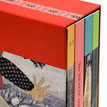| Joris-Karl Huysmans |
A Trip to Holland |
“This is Haarlem, Monsieur,” said my neighbour in the train
carriage, “you
can get out here.” I grab my bags and jump on to the platform.
I’m heading towards an exit gate when an inscription traced on the
station
pediment, ‘Uitgang,’ stops me. I stare; nowhere is the word ‘Haarlem’
written on it. My heart stops; my travelling companion was mistaken. I
lose
my head and I shout at the train: “Stop! Stop!” Everyone turns
around and
laughs at the sight of this foreigner calling after a departing train.
I spin
round and make signs to those near me that I don’t understand Dutch.
I
mime the hopeless despair of a man who has alighted too soon. I grimace,
pointing at the inscription over the front of the station, then, with a
dejected air, I repeat the word “Haarlem! Haarlem!” At which
the other
passengers repeat in unison, “Ja! Ja!”
What is going on? These people are very kind to be concerned about
me, but their bearded faces emit only guttural noises, the meaning of
which escapes me. Finally a man arrives who gabbles a little French. I
recount my misadventure to him, at which he begins to shake with laughter.
He ends up by telling me that I am in Haarlem, that the word ‘Uitgang’
isn’t the name of the station, but rather the word that signifies
the entrance
or exit to the station, I can’t remember which now.
I feel perfectly ridiculous, especially as the man describes the enormity
of my blunder to those standing by and they all laugh.
I take the man by the sleeve of his jacket, and, determined to flee as
quickly as possible, I say to him: “I was expected here last night
by an uncle
who lives in the city; but I missed the train. I can’t see anyone
at the station
waiting for me and my suitcase is so heavy it hurts to lift it. Where could
I
find a cab?”
He obligingly takes me to a cabdriver, who makes ready with his harness.
I give him the address ‘Oude Gracht’, which my rescuer corrects
the
pronunciation of, and so, driven by a coachman whose face is ringed by
a
thin beard like those of certain old monkeys, I bowl along the cobbled
streets of the town.
Through the frame of the coach window I stare at the passing canals
whose pistachio-coloured waters bathe the feet of step-gabled houses, their
tops pierced here and there by round sky-lights encircled by ornamental
dolphins, upright, heads down and tails in the air. A peal of bells rings
out,
followed by six chimes; the houses begin to stir; everywhere servants are
washing and sweeping, big jolly women in clogs, their ample breasts constrained
by corsets decorated with small flowers, and while some burnish
brass door plaques or polish concealed mirrors, those spy-glasses that
everygood Hollander keeps in his window, others spray jets of water on
to the
brown bricks of the walls or scrub with big circular motions of their arms
the terracotta slabs of the pavement.
The coach pulls to a halt. I get out, the door opens, and I fall into their
arms. I explain why I’m late, and they take me to my room. I catch
sight of
myself in the mirror: I look like a hundred-year old chimney-sweep. I peel
the dirt off my face and scrub, for my ears are full of coal dust and my
nostrils
black. Finally, I manage to repair the ravages of the journey, and go
back downstairs. It’s strange, all the same, the smell that houses
in Holland
seem to have: an elusive aroma, a vague hint of cloves and gingerbread.
And then, food is served! Steaming hot tea in cups, smoked-beef sandwiches,
buttered rye-bread and a fruit loaf, all come in succession; then
some finely-grated cheese in a kind of compote dish, and some red aniseed
on a saucer.
—
JORIS-KARL HUYSMANS (1848-1907) first published his Decadent masterpiece
A
Rebours (Against Nature) in 1884. Robert Baldick’s unsurpassed
English translation
is available from Penguin. The present Dutch travelogue was originally
published
in two issues of the Revue illustrée, no. 25 and no. 27 (December
1886 and
January 1887). Brendan King maintains an excellent Huysmans website
(http://www.huysmans.org) and has also translated Huysmans’ La
Bas, Parisian Sketches, Marthe and a revised and annotated re-edition of Baldick’s
The Life of
J.-K. Huysmans. The excellent Societé J.-K. Huysmans may be reached
at Centre
de recherche sur la litterature française de XlXe siécle,
Université Paris-Sorbonne,
1 rue Victor Cousin, 75230 Paris.
For the complete article purchase The Sienese Shredder
#1
Back to The Sienese Shredder #1
| 

